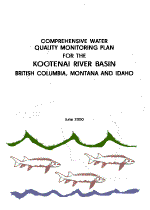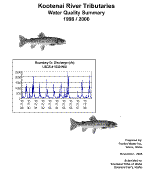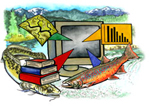Bibliography Background About KRIS
Kootenai River Water Quality
The Kootenai River Network, the sponsor of the pilot KRIS Kootenai project, and the Kootenai Tribe have funded comprehensive water quality studies of the Kootenai Basin (Bauer, 2000; Century West engineering et al., 2000). Water quality data in the pilot KRIS Kootenai project come from these reports which are excerpted and linked below. Although no data from Canadian agencies were included in this pilot project, a typical report from the B.C. Ministry of Environment, Land and Parks is included below as a reference (Webber and Wipperman, 1996). In other areas where KRIS projects have been conducted, Total Maximum Daily Load (TMDL) studies have provided critical information for watershed analysis and a full-scale KRIS Kootenai project would enfold results from TMDL studies currently underway.
Kootenai River Basin Water Quality Monitoring Plan
Monitoring Plan Goals and Objectives
 "The goal of the comprehensive water quality and aquatic habitat monitoring program is to determine basin-wide water quality and aquatic habitat status and long-term trends. The monitoring information and public education efforts can be used for proactive, scientifically based land and water resource management in the watershed, including the implementation of priority restoration projects.
"The goal of the comprehensive water quality and aquatic habitat monitoring program is to determine basin-wide water quality and aquatic habitat status and long-term trends. The monitoring information and public education efforts can be used for proactive, scientifically based land and water resource management in the watershed, including the implementation of priority restoration projects.
The objectives of the monitoring plan are varied due to the diversity of the watershed and the comprehensive nature of the KRN membership. The key objectives are as follows:
- Develop sound scientific baseline information so that future regulation and land management strategies affecting water quality are based on scientific fact
- Provide information to determine whether water quality standards are being met in both the tributaries and the mainstem (functional trophic interactions, water chemistry, habitat and fisheries)
- Identify water quality impaired streams and prioritize basin-wide restoration projects
- Monitor the effectiveness of restoration techniques using standardized pre- and post-monitoring plans
- Provide information to support community participation in stream restoration projects, stream monitoring and decision making
- Support enhanced management of native aquatic species in the watershed
- Evaluate the effect of water quantity on stream form and function in flood-prone areas (proper functioning condition)."
Kootenai River Tributaries Water Quality Summary, 1998/2000.
 "The Kootenai Tribe monitors the water quality of the Kootenai River watershed in Idaho as part of an ecosystem recovery program. Data has been collected from the Kootenai River, major tributaries, and the inlet for the Kootenai Tribe Hatchery. The purpose of this report is to evaluate water quality conditions in tributaries to the Kootenai River for data collected during the period from August 1998 to February 2000.
"The Kootenai Tribe monitors the water quality of the Kootenai River watershed in Idaho as part of an ecosystem recovery program. Data has been collected from the Kootenai River, major tributaries, and the inlet for the Kootenai Tribe Hatchery. The purpose of this report is to evaluate water quality conditions in tributaries to the Kootenai River for data collected during the period from August 1998 to February 2000.
The tributaries to the Kootenai River support resident and adfluvial fish populations and influence the unique fisheries (sturgeon and burbot) in the Kootenai River. Water quality is evaluated as a limiting factor to the aquatic communities in these tributaries and their consequent influence on the Kootenai River. There have been two primary concerns with water quality in this reach of the Kootenai River: first, the potential effect of trace contaminants (metals) from anthropogenic sources on the aquatic community, and secondly, the low nutrient status that limits productivity in the Kootenai River. The following objectives provide the direction for this data analysis:
- Objective 1: Evaluate trace metal contaminants in water as a potential limiting factor for fish populations in the tributaries to the Idaho reach of the Kootenai River.
- Objective 2: Evaluate tributaries as a source of nutrients to the Kootenai River."
References
Bauer, S.B. 2000. Kootenai River tributaries - water quality summary - 1998/2000. Prepared by Pocket Water, Inc. for the Kootenai Tribe of Idaho. Bonners Ferry, ID. 39 pp. [465k]
Century West Engineering, Aqua-Tex Scientific Consulting, Ltd., Summit Environmental, and EcoAnalysts, Inc. 2000. Comprehensive water quality monitoring plan for the Kootenai River Basin, British Columbia, Montana and Idaho. Prepared for the Kootenai River Network, Inc. 231 pp. [1.4Mb]
Webber, T.N. and B. Wipperman. 1996. State of water quality of Moyie River at Kingsgate, 1979-1995. Part of the Canada-British Columbia Water Quality Monitoring Agreement. Published by Province of British Columbia, Ministry of Environment, Lands and Parks. http://wlapwww.gov.bc.ca/wat/wq/quality/moyie/
